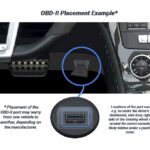Modern vehicles are complex networks, constantly exchanging a vast amount of data about their operation. These in-vehicle network messages provide crucial insights into vehicle status, driving conditions, and diagnostic trouble codes. For professionals in vehicle diagnostics and data acquisition, understanding how to access and interpret this data is essential. This article delves into the different types of vehicle network databases, focusing on the critical role of J1939 Obd2 in accessing comprehensive vehicle information. To effectively retrieve the vehicle data you need, familiarity with these four database categories is key:
- Generic OBD-II
- Enhanced OBD
- Normal Messages
- Direct Memory Reads (DMRs)
Understanding OBD-II Standards
Generic OBD-II is the standardized diagnostic system mandated for all cars and light trucks manufactured after 1996. Governed by SAE J1979, it provides a common set of diagnostic parameters, with approximately 40 out of nearly 100 specified parameters typically accessible in a standard vehicle. These parameters predominantly focus on engine-related data.
Examples of data available through generic OBD-II include parameters like Absolute Throttle Position, Air Flow Rate from the Mass Air Flow (MAF) sensor, Engine Coolant Temperature, Engine Speed (RPM), and Vehicle Speed. However, it’s important to note the limitations of generic OBD-II. Parameters such as odometer readings, steering angle, braking status, or any chassis and handling related information are not accessible via this standard.
While many commercial OBD data loggers offer generic OBD-II database access, they might restrict the number of parameters you can acquire. However, tools like HEM Data’s DAWN Mini Loggers are designed to overcome this limitation, allowing users to select and acquire any and all available parameters as needed. The accompanying software intelligently determines which parameters are supported by the specific vehicle being analyzed.
Expanding Diagnostics with Enhanced OBD (EOBD)
Enhanced OBD, often referred to as EOBD, represents an OEM-specific expansion of diagnostic capabilities. It mirrors the database utilized by dealership service scan tools, offering a significant advantage by potentially encompassing all electronic control units (ECUs) across the vehicle, not just the engine control module. Depending on the vehicle manufacturer, Enhanced OBD typically operates using either mode $21 or mode $22.
While service scan tools are valuable for targeted diagnostics, their design is generally geared towards single controller access at a time, with limited display and storage capacity. This makes them less suitable for comprehensive data acquisition or as effective data loggers. In contrast, the HEM Data’s DAWN OBD Mini Logger is engineered to support both mode $21 and mode $22, providing broader access to Enhanced OBD data. EOBD databases are available from HEM Data, and inquiries for specific vehicle compatibility are encouraged.
Delving into J1939 for Heavy-Duty Vehicles
Normal messages, also known as broadcast or functional messages, are transmitted continuously on the vehicle network without requiring explicit requests. These messages are broadcast because various controllers within the vehicle system require this information for their operation. In passenger cars and light trucks, the source address of these messages is typically not included in the message itself. However, in heavy-duty and off-road vehicles, adherence to the SAE J1939 standard means the source address is embedded within each message ID.
Normal messages are often documented and structured using .DBC files. Access to these files is highly protected by automotive OEMs due to the proprietary nature of the data. The SAE J1939 specification for heavy-duty vehicles defines an extensive library of nearly 2000 parameters. In practice, a specific heavy-duty vehicle might broadcast anywhere from 100 to 400 of these normal parameters.
For applications involving heavy-duty vehicles and J1939 OBD2 communication, the DAWN OBD Mini Logger from HEM Data provides robust support for capturing and analyzing normal messages. HEM Data supplies the J1939 database, facilitating the identification of parameters available on a given heavy-duty vehicle. For automotive applications where normal messages are of interest, users will need to import the relevant .DBC file into the DAWN software.
Advanced Access with Direct Memory Reads (DMRs)
Direct Memory Reads, or DMRs, represent the most granular level of data access, allowing for the reading of specific memory locations within a controller. This database type is exceptionally protected and primarily utilized by controller developers for in-depth analysis and debugging. DMR databases are commonly stored as .A2L files. For applications requiring DMR level access, the OBD Mini Logger remains the appropriate tool.
Bridging OBD2 and J1939: Comprehensive Vehicle Data Acquisition
Understanding the nuances of Generic OBD-II, Enhanced OBD, Normal Messages (including J1939 OBD2), and DMRs is crucial for anyone working with modern vehicle data. While Generic OBD-II provides a standardized entry point, accessing the full spectrum of vehicle information often necessitates exploring Enhanced OBD and Normal Messages, particularly J1939 in heavy-duty contexts. For the deepest level of analysis, DMRs offer unparalleled access, albeit with increased complexity and security considerations. Choosing the right database type and data logging tools, such as the DAWN OBD Mini Logger, empowers engineers and technicians to effectively decode vehicle network communication and extract the precise data required for their specific applications.
